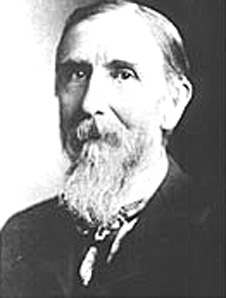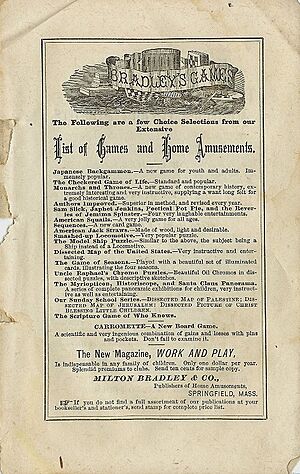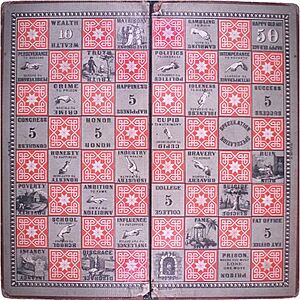Milton Bradley facts for kids
Quick facts for kids
Milton Bradley
|
|
|---|---|
 |
|
| Born | November 8, 1836 |
| Died | May 30, 1911 (aged 74) Springfield, Massachusetts, U.S.
|
| Occupation | Entrepreneur Board game manufacturer |
| Signature | |
Milton Bradley (born November 8, 1836 – died May 30, 1911) was an American businessman. He was a pioneer in making and publishing games. Many people say he helped start the board game industry. He created the Milton Bradley Company, which was later bought by Hasbro in 1984.
Contents
Milton Bradley's Early Life
Milton Bradley was born in Vienna, Maine, in 1836. His parents were Lewis and Fannie Bradley. His family moved to Lowell, Massachusetts, in 1847.
After high school in 1854, he worked as a draftsman. A draftsman draws detailed plans for machines. He also worked as a patent agent. Later, he studied at the Lawrence Scientific School in Cambridge, Massachusetts.
Milton Bradley moved to Hartford, Connecticut, with his family. He could not find a good job there. In 1856, he moved to Springfield, Massachusetts. Here, he worked as a mechanical draftsman.
In 1859, Bradley went to Providence, Rhode Island. He learned about lithography, which is a way of printing. In 1860, he opened the first color lithography shop in Springfield, Massachusetts.
The Idea for a Game
Milton Bradley had an idea for a board game. He called it The Checkered Game of Life. This game was an early version of what became The Game of Life.
The Milton Bradley Company
Milton Bradley's journey into making board games started after a problem in his printing business. He printed and sold pictures of Abraham Lincoln. Lincoln was a presidential candidate at the time.
At first, the pictures sold very well. But then, Lincoln grew his famous beard. This made Bradley's prints look wrong. Customers wanted their money back. The pictures became worthless, so Bradley burned the rest.
Looking for a new project, Bradley found inspiration. A friend gave him an imported board game. Bradley realized he could make and sell similar games in America.
The Checkered Game of Life
In the winter of 1860, Bradley released The Checkered Game of Life. The game was an instant hit. Bradley sold his first few hundred copies in New York in just two days. By 1861, over 45,000 copies were sold.
Players would spin a teetotum (a spinning top). They moved to squares that showed good or bad things in life. For example, "influence" earned points, while "poverty" slowed them down. The first player to get 100 points won the game.
Older games, like The Mansion of Happiness, focused on being good. Bradley's game was different. It showed life as a journey to success. It linked good actions to achieving goals. This idea fit well with America's growing interest in wealth after the Civil War.
The game also fit with people having more free time. This led to great success for the Milton Bradley Company.
Milton Bradley's Legacy in Games
From 1860 and into the 1900s, the Milton Bradley Company was a leader in American games. They made many popular games, including:
- The Game of Life
- Easy Money
- Candy Land
- Operation
- Battleship
The company was bought by Hasbro in 1984. In 1998, Milton Bradley merged with Parker Brothers to form Hasbro Games. The Milton Bradley name was used until 2009.
Milton Bradley's Later Work
Milton Bradley also published books and pamphlets. These were about Friedrich Fröbel's kindergarten system. This system focused on early childhood education.
His company published two magazines: Kindergarten News and Work and Play. These magazines were not very profitable. Bradley's business partners stopped supporting them. But Bradley kept publishing them until he died. His friend George Tapley helped him continue making educational materials.
By the 1890s, the Milton Bradley Company made the first standard watercolor sets. They also made educational games. These included Bradley's Word Builder and Bradley's Sentence Builder.
Bradley was also the first to sell crayon packages with standard colors. This was before the Binney & Smith company made Crayola crayons. Bradley was very interested in art education. He created a new color wheel and wrote four books about teaching colors.
Milton Bradley's Family Life
In 1860, Milton Bradley married Vilona Eaton. They did not have any children. Vilona died in 1867.
In 1869, he married his second wife, Nellie Thayer. Milton and Nellie had two daughters.
Milton Bradley passed away on May 30, 1911. He was 74 years old. He was buried in Springfield Cemetery. His first wife, Vilona, and his parents were also buried there. His second wife, Nellie, was buried there after her death in 1918.
In 2004, Milton Bradley was added to the Toy Industry Hall of Fame. In 2006, he was added to the National Inventors Hall of Fame.
Books and Patents
Books Written by Milton Bradley
- Color in the Schoolroom, 1890
- Color in the Kindergarten, 1893
- Elementary Color, 1895
- Water Colors in the Schoolroom, 1900
- Bradley also published rules for playing croquet in 1866.
Inventions and Patents
- He invented the Myriopticon panorama viewer. This device showed scenes from the American Civil War.



